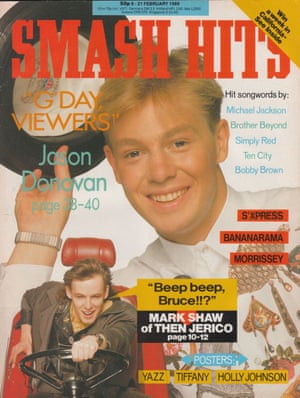
Interviews by Dave Simpson at the Guardian
David Hepworth – Editor: I was working in a record shop when a regular customer mentioned that Nick Logan was starting Smash Hits. I rang Nick and he said: “Can you come over tomorrow?” He’d put the first issues together on his kitchen table, but by the time I joined, in 1979, they’d just gone fortnightly and even had an office. The staff initially consisted of Nick’s 19-year-old sister-in-law, Bev Hillier, young designer Steve Bush, who’d run a T-shirt company in Lincolnshire, and me, a former drama teacher from Ossett, West Yorkshire. It was an unlikely group of people to launch a publishing revolution.
Nick left to launch the Face. I was editor from 1981 to 1983, one of many golden eras. Pop was getting more colourful – with the likes of Duran Duranand Culture Club – and Smash Hits was younger, more vibrant and more female than the rest of the music press. We thought pop stars were terrific, but absurd, so we developed a way of dealing with this supposedly glamorous world in mundane style. Adam Ant was called “Alan Ant”, Paul McCartney “Fab Macca Wacky Thumbs Aloft”. I came up with Tony “Foghorn” Hadley and depicted the Human League’s Phil Oakey as living in a house where his father and the budgie had the same lopsided hair.
The interview techniques were as cheeky. Tom Hibbert used to sit in silence, so the stars would nervously fill the gaps. Another of our writers, Neil Tennant, came up with “Does your mother play golf?” because the answer revealed if someone was posh. Most stars tolerated it because we sold hundreds of thousands of copies, and they could tell NME they didn’t need to talk to them. Paul Weller – or “Paul Welder” as we called him – said: “It’s like punk never ’appened” but he kept talking to us. The office was like a weird boarding school, where everyone called each other “Maaaan!” because it was the most ridiculous way to talk to someone when you’re from Yorkshire or Newcastle. But magical things happened.
Neil wangled a trip to see the Police play Shea Stadium in New York so he could visit his disco producer idol, Bobby O, and afterwards said: “He’s going to make a record with me!” How we laughed. When Neil left to form the Pet Shop Boys, we mocked up a cover, reading: “How I left Britain’s greatest pop magazine to become a pop star and then came back with my tail between my legs.” Which, of course, he never did.
Sylvia Patterson, writer
I read Smash Hits before I wrote for it. NME was too academic for me when I was 14. Smash Hits felt like a brick through the window. The tomfoolery spoke to me like nothing else had. Everyone, no matter their cultural importance, was treated identically, whether Bruce Springsteen or Big Fun. We’d do things to make each other laugh. We put questions to Jason Donovan in German, which he found very amusing. We called the A-ha singer Morten “Snorten Forten Horten” Harket because that’s how we thought Norwegian people talked. “Chris de Bleeurgh” droned on about his “dear friend Princess Diana” and was so pompous and dreary that we reduced the typeface on the page until it was tiny and unintelligible and eventually just disappeared.

When I reviewed U2’s Where the Streets Have No Nameand wrote, “Excuse me, there are no streets in the desert”, an appalled Irish newspaper headline screamed: “U2’s Bono blasted by top pop mag”, so we got sacks of hate mail. The more serious stars were, the more banal our approaches. Jon Bon Jovi – AKA “hunky Jon Bon Jovi with the marvellous hair” – snatched my questions and yelled: “This is what I have to put up with.” One of them was “Do you like cats?” The magazine’s language was like Jeeves and Wooster. Sleazy rockers were dubbed “Uncle Disgusting”. I use the word crumpeteer to this day.
Although “Ver Hits” survived until 2006, everything changed when Madchester did for the giant pop people, and we couldn’t cope with dance music, because if artists didn’t have a personality, we had nothing. After interviewing Sonia, I wondered: “What am I doing here?” But I miss the working environment and spirit of irreverence. Norman Cook – who became Fatboy Slim – phoned to blame me personally for the end of his band the Housemartins, because we “made their comedy personas even more cartoon”. Norman was particularly irked that I’d asked his bandmate Stan: “Have you ever grown parsnips in a gumboot?” Stan replied: “No, but I have cultivated cress in a ceramic hippopotamus.”
David Hepworth’s Uncommon People: The Rise and Fall of the Rock Starsis published by Bantam Press. Sylvia Patterson’s memoir, I’m Not With the Band: A Writer’s Life Lost in Music, is published by Sphere.
*****
Collecting Vinyl Records, CDs & Memorabilia from the 80’s through to the current day? Rare, out of print, promotional/industry only – you’ll find it all here at eil.com
eil.com – the world’s best online store for rare, collectable and out of print Vinyl Records, CDs & Music memorabilia since 1987




Be the first to comment